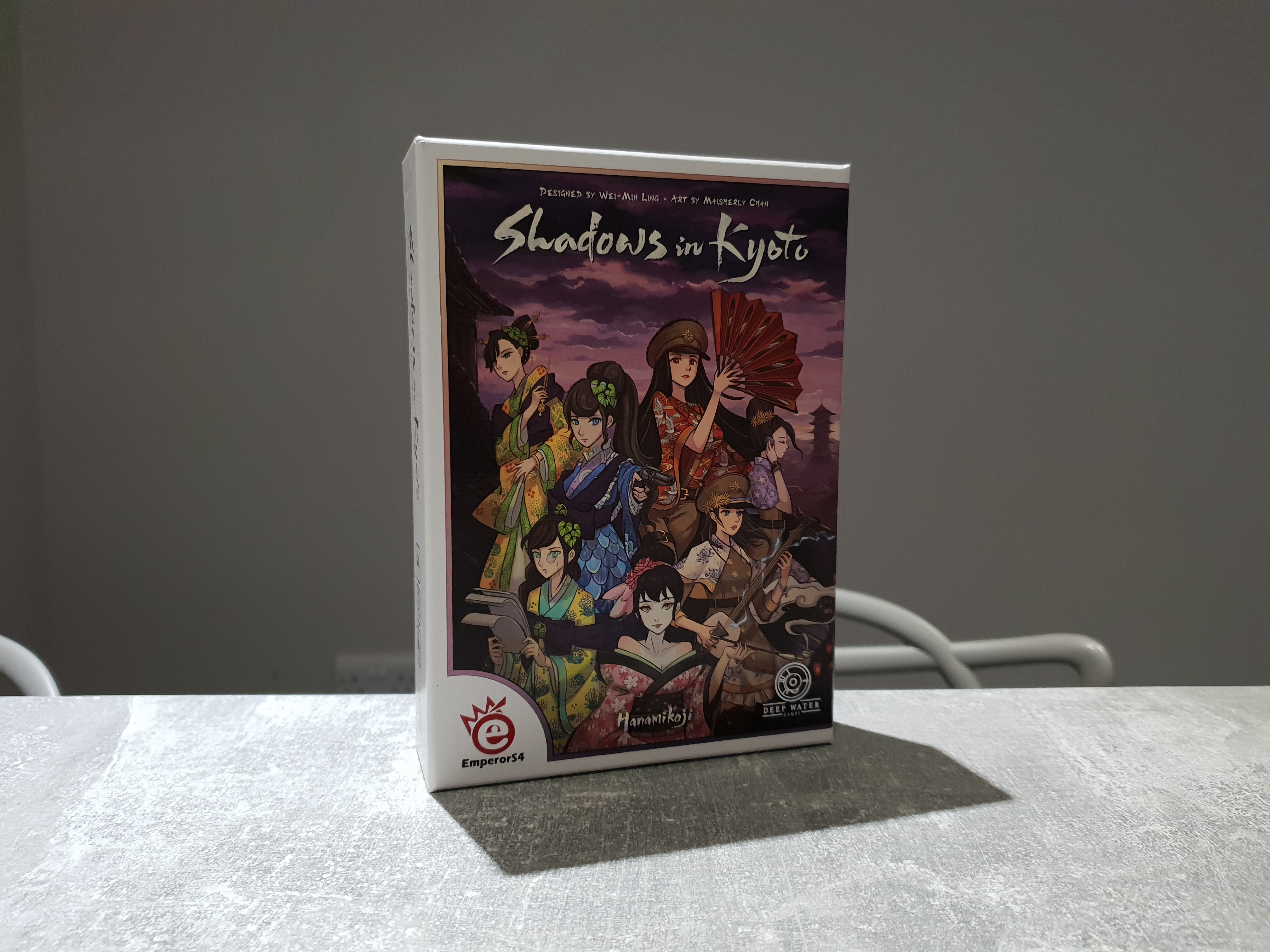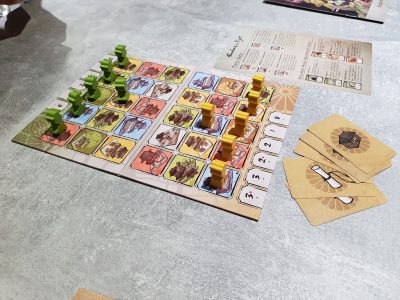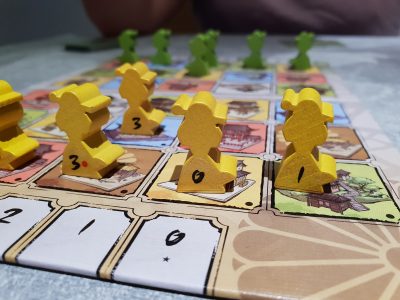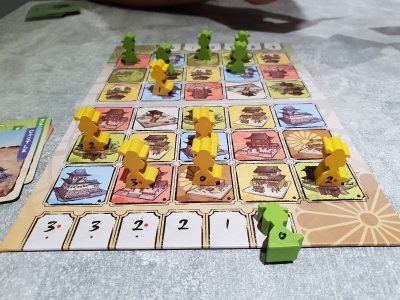Shadows In Kyoto is a abstract strategy title which was released back in 2017 by publisher EmperorS4. Designed by Wei-Min Ling, with artwork from Maisherly, the game is set in 1920s Japan. As a 2 player only title, the game sees players pitted against each other, with the Shogun protecting Oniwaban coming up against the Western Industrial Revolution funding government. Only taking around 10 minutes there are elements of hand management, bluffing and advanced rules for variable player powers. However, is this a conflict you’ll want to be on either side of? Let’s find out!
Information is key to victory for both the Oniwaban and the government. Both sides have identical sets of two intel carrying agents and 4 decoy agents. The two real intel carriers are denoted with red dots next to their numbers, which range from 0 – 3. At the start of the game both sides line up along opposite sides of the 6 x 5 space board, with a full back row of 5 agents, with a sixth out in front. Agent pieces must have their numbered side facing their owner as the positioning information is secret from your opponent. Both players take a matching deck of site and tactic cards, shuffling both separately. Drawing 6 cards, made of 4 site and 2 tactic cards, a basic game is ready to play.
Play goes back and forth between the two players. On a turn the active player plays a single card to their discard pile, follows the associated action and will potentially capture an enemy agent. The two card types act somewhat differently. Site cards see basic movement occur, moving to a space of the cards color or a neutral space. Any basic movement must be forward or diagonally forward by one space. If a space is already occupied by one of your agents, or it is your opponent’s HQ, your agents cannot move there. Tactic cards offer special movement options, including a backwards movement or tunneling across the board sideways. While these rightfully sound powerful there are a lot less of them, with each player having a total of 8 tactic cards and 25 site cards.
If you move onto a space with an enemy agent a conflict, or capture attempt, happens. Firstly, the defender lays their agent down, revealing the value and if it is carrying real intel. Next, the attacker must truthfully announce their agent’s value. Note, the attacking agent is not laid down, and information regarding real intel is not specifically revealed. Giving the advantage to the attacker, the agent numbers are compared via two rules: 3 > 2 > 1 > 0 and 0 > 3. For example, if a 3 or 0 attacker comes up against a defending 3 they win the conflict and capture the piece. This sees it removed from the board and placed into the confinement zone. If the attacker loses the conflict (e.g. a 0 attacker against a defending 2) then they return to where their started on the turn and play continues as normal.
At the end of a turn, if possible, the active player must draw back up to six cards from either of their draw decks. If one deck is depleted they must draw from the other and once both are depleted no cards are drawn. The game continues until one of three end conditions are meet. Capturing both enemy agents with real intel or getting one of your agents with real intel to your opponent’s back line wins the game, while capturing 3 enemy agents with fake intel will lose you the game.
Shadows In Kyoto also comes with two advanced variants which add unique player powers and equipment into the game. Note, for the first few games it is best to play the basic mode, before introducing either variant. When fully up to speed it is perfectly fine to include both advanced variants at once. The Charisma variant sees the Geishas from Hanamikoji return to take sides, with 3 unique powers to choose from for each side and a neutral card. After setup the two players take their sides cards and choose one, returning the rest to the box. These range from drawing multiple cards to marking more colour locations as traps for your opponent via the Bait tactic card.
Equipment, the second variant, adds in spy like items such as pocket pistols, a bulletproof fan and wireless bugs. At the start of each game players claim their colours 3 equipment cards, placing them greyed out side face up next to the board. When one of your four agents that is denoted with a star (separate from the dot of real intel agents) is captured you can flip a power over. It is then available for a one time ability, before being put back in the box. This can see a card returned from your discard pile through to gaining a second turn instantly after winning a conflict as the attacker. Neither hugely change the game, straying from what makes the basic experience fun. While I can’t see myself using both variants simultaneously in every game, having at least one variant included helps the game have a different feel each play.
Shadows In Kyoto seems to take the movement cards of Onitama and combines it with the bluffing, deduction and logic from Stratego. It may sound like an odd mix but it works well to produce a tactical game. While you can go in with a strategy, you’ll need to adapt to what cards you draw and what your opponent does. Keeping tactic cards in your hand can be perfect to dodge a sticky situation. On the other hand your opponent will know if you have drawn tactic cards, so the opportunity to bluff or double bluff comes in from the offing.
There is a tension built throughout the game not only from your opponent’s actions but also what you are deducing. If an enemy agent advances more than the rest, or your opponent makes a large change via a tactic card, there could be information to be learnt. Along the same lines, when you commit to a conflict not only is there the issue of beating the enemy agent number wise but then are they carrying real or fake intel. Having the balance of 2 real or 3 fake enemy agents as end game conditions can and does result in amazing game endings. It is entirely possible that you have one real and two fake intel carriers going into a final conflict, which could either win or lose you the game! Alas, not every single game ends with this amount of tension but there are at least peaks of satisfaction, relief and disbelief caused in every play due to the hidden aspect of the information.
Coming in the same small sized box as Hanamikoji, Shadows In Kyoto also heavily draws from that game’s artwork – with the same 7 Geishas present in more military attire. The board is kept relatively clean, though an increased amount of highlighting of the headquarters and wild locations would have been a nice touch for new players. The player pieces work perfectly for the size of board and the mostly transparent stickers for the numbers improve the visual appeal. The inside of the box could be slightly more organised and as always the box could be smaller but these are nitpicks for what is a solidly made title. Most importantly, the basic cards are simple to read and understand, vital for getting new players hooked on the gameplay – even if they are on the small side.
While the theming allows for the pretty artwork it does very little to inspire players. Perhaps this is partly due to the limited knowledge of the shogun era, as it isn’t exactly something that frequents common discussions. Neither does it allow for the Japanese mythology that captures gamers attention in other Japanese themed titles to seep in. Whether events of the time could have been used more strongly to inspire more actions/options for players is hard to say. The gameplay itself is solid, but it does little to elevate itself above the battle reasoning supplied in Stratego, which was released back in 1946. It might be a translational issue but the tunneling tactic card also confuses new players. Logically, you’d expect to be able to tunnel under other pieces but you cannot – merely bumping into them instead as part of a large sideways movement.
The way Shadows In Kyoto draws from other games instantly begs the question is it better to replace them or different enough to sit on the shelf alongside them. When it comes to Stratego all the deduction and conflict elements are there but in under half of the time. Neither of the themes speak stronger so Shadows In Kyoto comfortably wins, as it’ll get to the table easier. When it comes to Onitama they are different enough. Both have the odd movements but they are used more as special one time abilities in Shadows In Kyoto, which combines perfectly with the deduction elements. This is a small package the game that can provide all the highs and lows of titles in boxes many times the size and price. It is also incredibly easy to go from one game to another, asking for just one more game at the end, and for that reason it has earnt its space on my gaming shelf!
[Editor’s Note: Shadows In Kyoto was provided to us by Asmodee UK for review purposes. The game is currently available on 365 Games for £21.99. It is also available from local UK board game stores, find your local store here]




